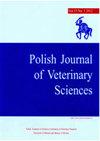Comparison of the effects of two commercially available prescription diet regimens on the fecal microbiomes of client-owned healthy pet dogs.
IF 1
4区 农林科学
Q3 VETERINARY SCIENCES
引用次数: 0
Abstract
In the present study, we used next-generation sequencing to investigate the impacts of two commercially available prescription diet regimens on the fecal microbiomes of eleven client-owned healthy pet dogs. We tested an anallergenic diet on 6 dogs and a low-fat diet on 5 dogs. Before starting the study, each dog was fed a different commercial diet over 5 weeks. After collecting pre-diet fecal samples, the anallergenic or low-fat diet was administered for 5 weeks. We then collected fecal samples and compared the pre- and post-diet fecal microbiomes. In the dogs on the anallergenic diet, we found significantly decreased proportions of Bacteroides, Ruminococcaceae, and Fusobacteriaceae, belonging to the phyla Bacteroidetes, Firmicutes, and Fusobacteria, respectively. The proportion of the genus Streptococcus belonging to the phylum Firmicutes was significantly increased upon administering the anallergenic diet. In the dogs on the low-fat diet, although the phyla Actinobacteria and Bacteroidetes tended to increase (p=0.116) and decrease (p=0.147) relative to the pre-diet levels, respectively, there were no significant differences in the proportions of any phylum between the pre- and post-diet fecal microbiomes. The anallergenic diet induced a significantly lower diversity index value than that found in the pre-diet period. Principal coordinate analysis based on unweighted UniFrac distance matrices revealed separation between the pre- and post-diet microbiomes in the dogs on the anallergenic diet. These results suggest that, even in pet dogs kept indoors in different living environments, unification of the diet induces apparent changes in the fecal microbiome.比较两种市售处方饮食方案对客户拥有的健康宠物狗粪便微生物组的影响。
在本研究中,我们使用新一代测序技术研究了两种市售处方饮食方案对11只客户拥有的健康宠物狗粪便微生物群的影响。我们在6只狗身上测试了过敏性饮食,在5只狗身上测试了低脂饮食。在开始研究之前,每只狗在5周内被喂食不同的商业饮食。收集饮食前粪便样本后,给予过敏性或低脂饮食5周。然后我们收集粪便样本,并比较饮食前和饮食后的粪便微生物群。在狗的过敏性饮食中,我们发现拟杆菌科、瘤胃球菌科和梭杆菌科的比例显著降低,分别属于拟杆菌门、厚壁菌门和梭杆菌门。给予致过敏饮食后,厚壁菌门链球菌属的比例显著增加。在低脂饮食的狗中,尽管放线菌门和拟杆菌门相对于饮食前的水平分别有增加(p=0.116)和减少(p=0.147)的趋势,但饮食前和饮食后任何门的粪便微生物组的比例都没有显著差异。致过敏日粮诱导的多样性指数显著低于日粮前。基于未加权UniFrac距离矩阵的主坐标分析显示,在过敏性饮食的狗中,饮食前和饮食后的微生物组之间存在分离。这些结果表明,即使在不同生活环境的室内饲养的宠物狗,统一的饮食也会引起粪便微生物群的明显变化。
本文章由计算机程序翻译,如有差异,请以英文原文为准。
求助全文
约1分钟内获得全文
求助全文
来源期刊
CiteScore
1.40
自引率
0.00%
发文量
60
审稿时长
12-24 weeks
期刊介绍:
Polish Journal of Veterinary Sciences accepts short communications, original papers and review articles from the field of, widely understood, veterinary sciences - basic, clinical, environmental, animal-origin food hygiene, feed hygiene, etc.

 求助内容:
求助内容: 应助结果提醒方式:
应助结果提醒方式:


